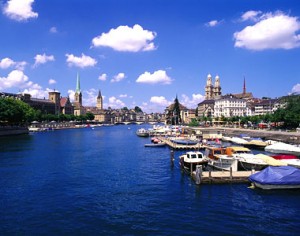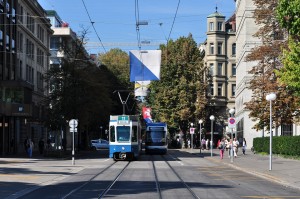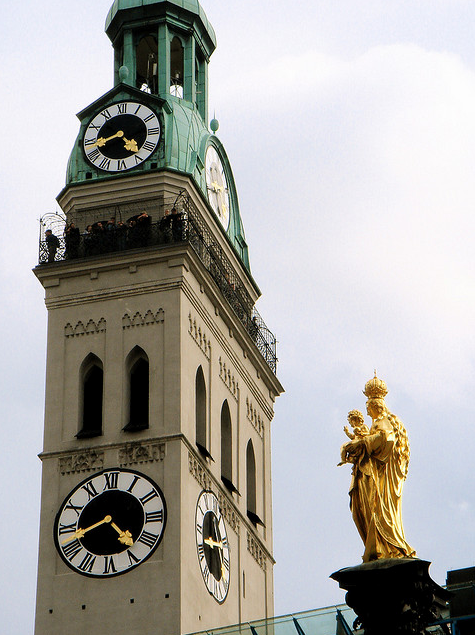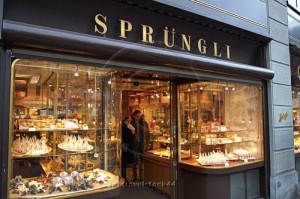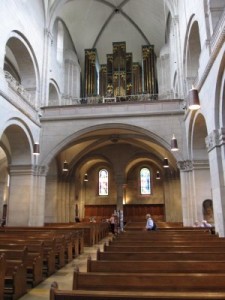This article is written by Cyrus Dadachanji, an avid food journalist, storyteller, non-fiction film and TV scriptwriter, researcher, advertising copywriter and poet, based in Mumbai
“Zurich is not only the banking centre of Switzerland, but it could also be called the geographic tourist centre.”
Imagine a city that’s the banking center of the world. A city where business hums quietly in glass fronted buildings. A city where transcations worth millions of dollars take place every day. And you’ll probably conjure up images of a mega-metropolis with skyscrapers, swank hotels and chaotic traffic. Well, it doesn’t work that way in Switzerland. Zurich, for all its importance on the international banking scene, has retained its small city charm. The skyscrapers are few and far between. The traffic hums about the city noiselessly as the citizens stroll by the lakeside, feeding swans. This is a city where immense wealth is generated, stored and spent on the good things it life. But the Swiss believe that the good things in life don’t necessarily need to be ostentatious or garish.
The best way to discover Zurich is to walk about the city. Discover its quaint squares, stop off at a sidewalk café or just go window-shopping at designer boutiques across the city. The city is small enough to walk about in a day or two, and allows you to set your own pace. This is definitely not one of those ‘must-see-this, must-do-that’ kind of places. But there are enough attractions to keep you occupied and enthralled for even a week, if you feel like lingering on.
“The church is best known for its clock tower, which boasts the largest clock face in Europe.”
Lace up your walking shoes and let’s take a stroll through one of the nicest big little cities in the world. The moment you arrive in Zurich, it’s very apparent that you’re in a wealthy, well-developed city. The airport is like a miny-city in itself. The airport complex has bus-stations, multi-level underground train stations, hotels, entertainment and business centres, multi-cuisine restaurants and public showers among other facilities that a traveller may require. Our walking trail begins at the city’s busiest street- the trendy Bahnhofstrasse. Although it’s the banking centre of the city, the street is lined with shops and sidewalk cafés, giving it a rather bohemiam feel. From the Bahnhofstrasse, it’s a short walk, though medeival lanes to the Lindenhof square, where one can still see traces of Zurich’s origins as a Roman trading centre. The fountain at the square commemorates the bravery of the women of Zurich, who tricked the Hapsburgs of Austria, by marching around the city walls in full military armour. The Hapsburgs thought that the city was heavily fortified and beat a hasty retreat. Seven hundred years later, the fountain is still treated with the respect a war memorial deserves. Just off the Lindenhof square lies another famous memorial that dates back to the middle ages. St. Peter’s Church or Peterskirsche, built in the 13th Century, is Zurich’s oldest parish church. The church is best known for its clock tower, which boasts the largest clock face in Europe.
The Peterskirsche Clock Tower
Zurich is a city of surprises. A few steps this way or that can take you from the medeival to the modern and back. Just a short distance from St. Peter’ s Church lies the Fraumunster church , which has modern stained glass windows painted by Chagall, in a modern style. Next to the Fraumunster, you’ll find a pair of graceful guild buildings belonging to the linen weavers and the wine merchants. Walk back towards the Bhnhofstrasse and give your sweet tooth free rein at Zurich’s most famous confectioneries and sweets shop, Sprungli at Paradeplatz. If you’re a chocolate fan, don’t miss the Chocolate Truffle – it’s positively sinful.
The Sprungli at Paradeplatz
After indulging in Sprungli’s sinful delights, walk down the Bahnhoffstrasse to Quai bridge, from where you can enjoy the panoramic landscape of Lake Zurich in all its pristine glory. Follow the road up to theKunsthaus or art gallery on Ramistrasse. The art gallery has an extensive collection of medeivial paintings, Dutch and Italian baroque masterpieces as well as many works by Swiss artists. Take a left from the art gallery and you’ll discover one of Zurich’s finest examples of late Gothic architecture, the Wasserkische or Water Church. A little further down the road lies the 11th Century Grossmunster church. The church was founded by emperor Charlemagne, after his horse stumbled at this site, way back in the 9th Century!
The interiors at Grossmunster church
Wander back towards the river Limmat towards Limmatquai, where you’ll find some of Zurich’s most enchanting buildings, many of which have been converetd into restaurants. The Haus zum Roden is actually a 300-year old noblemans’ hall with a grand wooden ceiling. You can dine on Swiss delicacies like veal sausages, rosti or potato salad and wash it down with a little corn beer as you soak in the ambience. Sated, you can step back a few more centuries in the Alstadt or medeival section of the city. The Alstadt is a charming maze of medeival streets and buildings, where time seems to have stood still. It’s amazing how a few minutess in this area can transport you into a totally diferent era, exclusively through the medium of its architecture. Walk back towards the river through a very modern Niederdorf, which is Zurich’s entertainment and nighlife district. The Neiderdorf has its share of pubs, discos, strip shows, cabarets and other forms of entertainment. After all, the Swiss love spending money as much as they like making it.
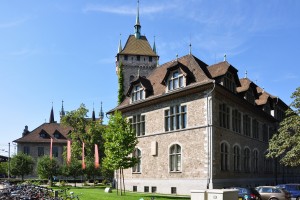 The Swiss National Museum, Zurich, also known as Landesmuseum
The Swiss National Museum, Zurich, also known as Landesmuseum
One of the city’s finest museums is almost adjacent to the main station or Hauptbahnhof. The Swiss National Museum, otherwise known as the Landesmuseum is the perfect place to get a feel of Swiss culture and history. The museum has a fascinating collection of pre-Romanesque and Romanesque church art, glass paintings from the middle ages, ceramic stoves, ancient gold and silver ornaments and a veriety of weapons used over the centuries. Another museum that is truly worth seeing is the Reitburg Museum. The museum is set in a qauint little neo-classical mansion amid a sprawling garden on Gablestrasse. It’s very easy to mistake the museum for just another well maintained home, until you step in. The museum has a eclectic mix of art and artefacts from Asia, China, Japan and Africa and is well worth a visit.
“Zurich has a two-storey beer emporium which stocks over 2000 different types of beers from around the world.”
Switzerland may not exactly be a shopper’s paradise, but all the same, any shopper worth his or her salt shouldn’t leave Zurich without a serious look at the shops along the Bahnhofstrase. From department stores to boutiques, each outlet has the finest in watches, clocks, jewellery, music boxes, crystal, embroidered items, handicradfts, porcelain, silverware and the ever faithful Swiss Army knives! You’ll also find enough varieties of chocolates and cheese to make your head spin! If you’re a beer lover, Zurich has a two-storey beer emporium which stocks over 2000 different types of beers from around the world. The collection of unknown beers packed in unconventional bottles, cans and casks vies with the beer memorabilia collection, which is really worth seeing – even if you’re not a beer lover!
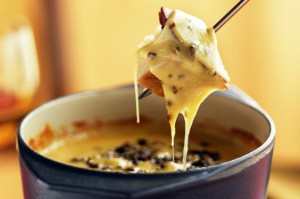 The Swiss believe that life is meant to be lived to its fullest! So, they eat and drink to their heart’s content, in whaterver establishment suits their pockets. Most Swiss food is meat based, with veal sausages, steaks and stews topping the list. When temepratures drop in winter, the locals indulge in a bit of fondue to keep them warm. The traditional fondue is a community experience, where a group of diners armed with skewred meat or bread, gather around a cauldron of melting cheese. The meat is then dipped into the cheese and eaten while it’s hot. Zurich has quite a few economical resturants (by Swiss standards), where the locals gather to dine on meat platters and sausages, washed down with copious amounts of beer! The Zeughuskeller, for example is a 510-year old arsenal, that was once used to store cannons and other instruments of mayhem. Today, it’s a bustling restaurant set in the cavernous stone and wodden beamed hall. The speciality of the house is a giant veal sausage served with a potato salad and it’s worth every franc.
The Swiss believe that life is meant to be lived to its fullest! So, they eat and drink to their heart’s content, in whaterver establishment suits their pockets. Most Swiss food is meat based, with veal sausages, steaks and stews topping the list. When temepratures drop in winter, the locals indulge in a bit of fondue to keep them warm. The traditional fondue is a community experience, where a group of diners armed with skewred meat or bread, gather around a cauldron of melting cheese. The meat is then dipped into the cheese and eaten while it’s hot. Zurich has quite a few economical resturants (by Swiss standards), where the locals gather to dine on meat platters and sausages, washed down with copious amounts of beer! The Zeughuskeller, for example is a 510-year old arsenal, that was once used to store cannons and other instruments of mayhem. Today, it’s a bustling restaurant set in the cavernous stone and wodden beamed hall. The speciality of the house is a giant veal sausage served with a potato salad and it’s worth every franc.
“Zurich is not only the banking centre of Switzerland, but it could also be called the geographic tourist centre.”
Zurich is not only the banking centre of Switzerland, but it could also be called the geographic tourist centre. There are a number of attractions that are just an hour or two away from the city. On the one hand you have the picturesque Rhinefall, where you can take a boat ride to the base of one of Switzerland’s mightiest falls and experience its wesome power and beauty up close. Then there is the Bern Oberland, with the capital city and a vast network of picturesque lakes and mountains. You can take a ride in a paddle steamer at Interlaken or visit the top of Europe at Jungfraujoch. Both have the sort of pristine beauty, that is so typical of the Swiss landscape. Many of the peaks in this area like Mt. Titlis and Mt. Pilatus are accesible by cable-car, providing the tourist with breathtaking Alpine vistas along the way. And when you’ve had your fill of the great outdoors, Zurich will lure you back with its sophisticated charm. And that’s a promise you can bank on!
Cyrus Dadachanji
2010
http://www.gypsytales.com/RICH_RICH_ZURICH.htm
